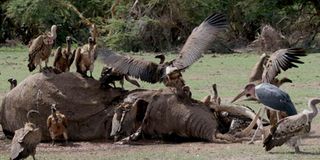Kenya faces ecological and economic fallout from elephant deaths

Vultures feed on a dead elephant at the Amboseli National Park.
What you need to know:
- Reports of herds of tens of elephants dying in protected parks have become a common occurrence in recent years.
- At only 16,000 in 1989, the elephant population in Kenya’s wild more than doubled to about 34,000 by end of 2019, thanks to painstaking conservation efforts. The shocking deaths are, however, fast reversing the gains made to restore the numbers.
Kenya is losing its elephant population at a frightening rate since poaching was tamed more than three decades ago. Reports of herds of tens of elephants dying in protected parks have become a common occurrence in recent years.
At only 16,000 in 1989, the elephant population in Kenya’s wild more than doubled to about 34,000 by end of 2019, thanks to painstaking conservation efforts. The shocking deaths are, however, fast reversing the gains made to restore the numbers.
Between August and December last year, 62 elephants succumbed to starvation as drought hit Tsavo National Park in coastal Kenya in an incident that left the country in consternation. This figure is contested, with some quarters citing more casualties.
The Tsavo ecosystem is home to more than a third of Kenya’s elephants at about 15,000 as of the 2021 census.
Kenya Wildlife Service (KWS) did not respond to Healthy Nation’s queries on the government’s proposed plan to drill water pans, dams and boreholes at the park to mitigate the disaster.
In 2018, 26 elephants died at Maasai Mara National Reserve, while 11 others were suspected to have been poisoned. Mara Elephant Project (MEP) cited a strong pesticide as possible cause of death.
But what is killing Kenya’s elephants? What does the death of an elephant mean to Kenya?
Kenyan elephants, also called African elephants, mature at between 10 and 12 years. Elephants at Amboseli National Park mature at 15 years, according to Elephant Voices, an initiative for elephants’ welfare.
Some deliver their first calf at 10. Calves of young mothers, though, have minimal chances of survival due to raising inexperience.
The gestation period of an elephant is a long one, lasting a staggering 22 months, with only single calves born. Although an elephant can give birth to twins, this occurrence is rare.
After their first birth, they continue to reproduce into their 50th birthday. Some give birth in their 60s although this is uncommon.
In the wild, an elephant can live up to 60 years, and 80 years in captivity, according to Britannica. Despite their relatively long lifespan, elephants birth only a few calves. This is partly because it takes longer to wean a baby elephant, with some suckling into their third birthday.
The death of one elephant, therefore, sets the country back an average of 17 years, and longer when the animal’s age is factored in. The death of 50 animals is an ecological catastrophe.
So, what are the consequences of an elephant’s death?
Foremost, an adult elephant consumes an average of 100 kilogrammes of herbage and 100 litres of water per day. A starving elephant can consume more.
By eating such large quantities of food, elephants help to control overgrowth of vegetation in the wild, thus allowing smaller grazers and browsers to feed with ease, which then provide food to hunters.
The death, injury or illness of key members of the herd have overwhelming effects on the psychological wellbeing of the rest.





